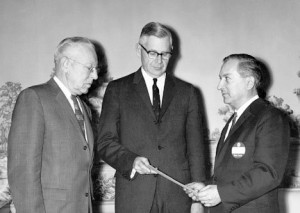Looking Back: #EXT100Years
April 29, 2014 in Articles
This post is the part of a series commemorating the 100-Year anniversary of the signing of the Smith-Lever Act which officially created the national Cooperative Extension Service.
Read More about the 100-year anniversary of Cooperative Extension.
Looking Back at Penn State Turfgrass
 The state of affairs in turfgrass management in the year 1935 was somewhat bleak as the “Great Depression” lasted nearly 15 years. Professor H.B. Musser was in charge of turfgrass research at Penn State. Dr. Fred Grau recieved his Ph.D. from the University of Maryland and was hired as Penn State’s first extension agronomist in turf. His responsibilities as turf extension specialist were to evaluate problems in the field and discuss them with research personnel who would then try to solve them. Musser and Grau addressed a meeting of Pennsylvania and Ohio turfgrass managers on the subject of developing classes at Penn State for young men who would like to become turf managers; they were repulsed by the curt statement, “we don’t want young college-trained whippersnappers coming in to take our jobs.”
The state of affairs in turfgrass management in the year 1935 was somewhat bleak as the “Great Depression” lasted nearly 15 years. Professor H.B. Musser was in charge of turfgrass research at Penn State. Dr. Fred Grau recieved his Ph.D. from the University of Maryland and was hired as Penn State’s first extension agronomist in turf. His responsibilities as turf extension specialist were to evaluate problems in the field and discuss them with research personnel who would then try to solve them. Musser and Grau addressed a meeting of Pennsylvania and Ohio turfgrass managers on the subject of developing classes at Penn State for young men who would like to become turf managers; they were repulsed by the curt statement, “we don’t want young college-trained whippersnappers coming in to take our jobs.”
During this time many turfgrass managers were sowing seed on hard-packed soils with a wheelbarrow seeder. Very little of the seed grew because there was no soil cultivating equipment and the maintenance of grasses consisted of more “secrets than science.” Fertilizers for the most part, were high-phosphorus farm grades, sulfate of ammonia, and activated sewage sludge. In Philadelphia, Charles Hallowell was the county agent involved with turf, while in Pittsburgh, Henry Eby had the same interest and function. The use of sodium arsenite for weed control in turf was a popular topic for discussion at meetings and for demonstrations on athletic fields and golf courses. Leo Previti from Municipal Stadium was among the early leaders in the use of sodium arsenite.